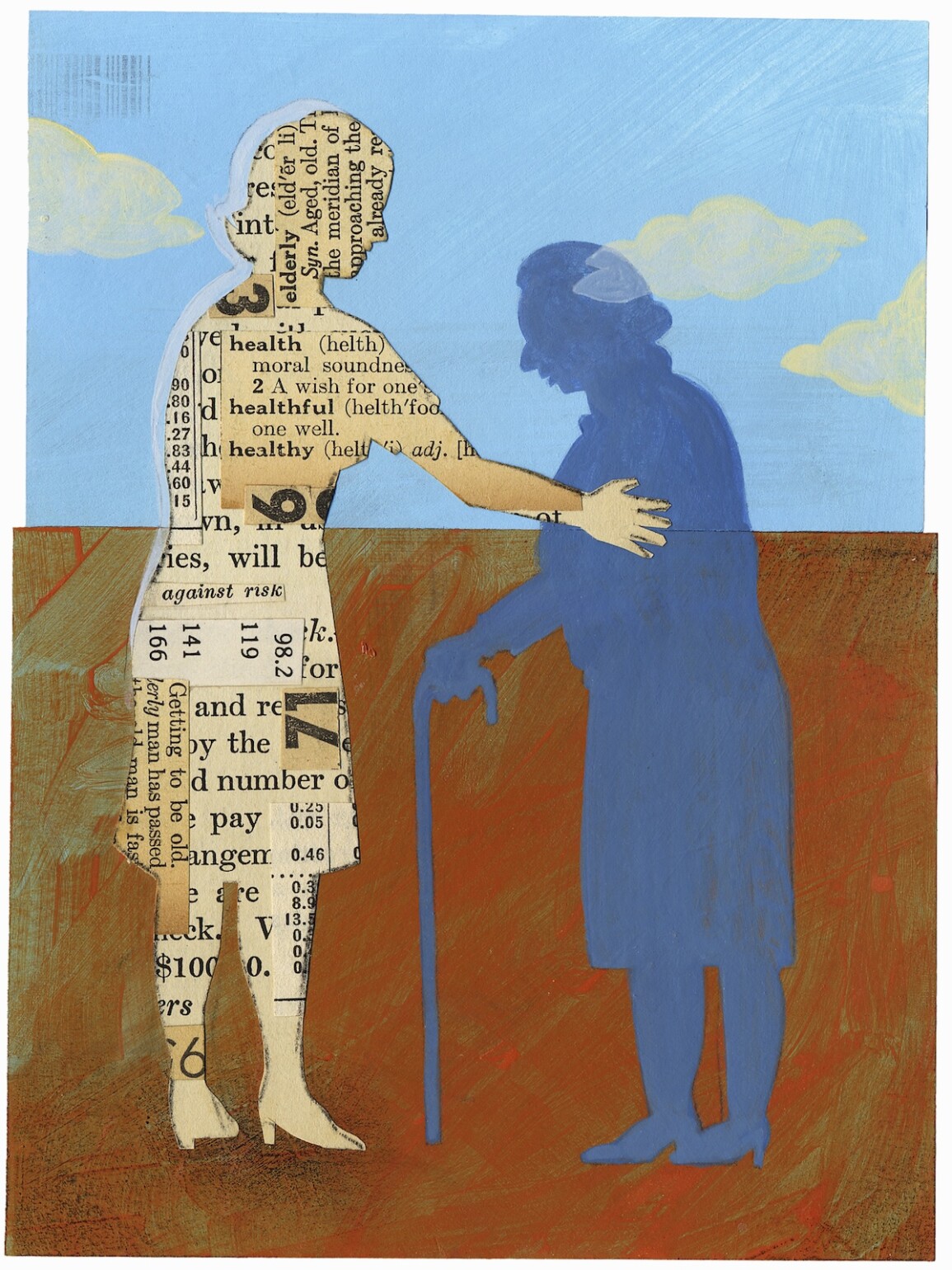When Sarah Oliver tried to arrange a few hours of daily home care for her aging mom, she ran into one of Marin country’s elder care challenges.
“Most of the caregivers can’t live in the Bay Area,” due to the high cost of living here, Oliver says. “So they want to work at least 12 hours, or 24/7, to make it worth commuting. It was a real struggle in the beginning.”
With Marin’s huge senior population — a quarter of the county’s residents are over 65, compared to just 17% nationwide — many residents looking for elder care run into similar roadblocks. Many have to do with the local cost of living.
“The (adult) children often don’t stay nearby because they can’t afford to buy a home here,” says Anne Grey, CEO of San Rafael nonprofit Vivalon.
Despite its challenges, Marin is rich in resources for seniors and their families.
Services for independent seniors

On a recent weekday morning, students peered over the rims of their glasses at tablets and smartphones, concentrating on a technology lesson. The teacher projected her own phone’s screen onto a smart board, demonstrating how to use the camera to scan a document. The smell of fried chicken wafted from the cafe, where volunteers prepped for the lunch crowd.
This is Vivalon, a comprehensive resource for seniors who are fully independent, or who need just a little help. Formerly known as Whistlestop, the 70-year-old nonprofit opened its new Healthy Aging Campus in January. The complex feels like a senior center/college campus mashup, with 66 affordable senior housing units, classrooms, a cafe, a tech center and a resource office that can help members find housing or legal aid. Vivalon also offers transportation services, as well as a pickup food aid program and two separate meal delivery programs. This summer, a branch of Marin Community Clinic will open on the ground floor.
“The vision is that people come in to get their regular medical care, stay for lunch, stay for a class and just thrive fully in what we offer here,” Grey says.
Aging in place
Although Oliver showed her mom, Carol, a number of attractive senior communities, Carol was determined to stay in her own home. That’s not uncommon, says Laura Belluomini, founder of Marin Home Care, a licensed agency in Tiburon.
“A lot of seniors, especially here in Marin, feel there isn’t anywhere quite as comfortable as your home, where your kids grew up,” Belluomini says.
For some, aging safely at home might necessitate adding a chair lift or making other modifications. If the senior has trouble meeting their own needs for hygiene, cooking or mobility, an in-home caregiver may be needed.
Oliver connected with Marin Home Care, which eventually found her a part time caregiver. After a hospitalization left Carol with more needs, the agency matched them with a 24/7 caregiver. Such services aren’t inexpensive anywhere in the country, much less in Marin. Marin Home Care’s rate for round-the-clock non-medical care starts at $699 a day, with nurse or physical therapist visits potentially adding hundreds more. That’s in line with the $20,000 per month that Aging Solutions, a San Rafael firm that helps families navigate elder care, tells clients to expect.
“People are going to want to hire people privately because of the cost,” says Terri Abelar, Aging Solutions founder and CEO. While it might be tempting to hire someone under the table to avoid taxes and overtime, or even arrange a casual situation like a roommate for a senior who just needs company, Abelar warns that trying to handle home care without an agency is risky. Abelar had to help her own aunt, at age 108, handle a legal dispute springing from a casual arrangement. Licensed agencies protect families from issues by running background checks, handling employment contracts, offering coverage if the primary caregiver gets sick, and carrying insurance in case anything goes wrong.
When her own mother, battling cancer, needed care in her southern California home, Abelar worked with a home care agency. Along with Aging Solutions staff and hospice, agency staff handled all her mothers’ medications and therapies.
“That gave me the opportunity to just be with my mom,” says Abelar, whose mother passed away at home last summer. “As devastating as it is to lose your mom, I’m thankful for how we were able to manage her quality of life. She had a hospital bed, but she was still in her bedroom. She could still see her dogs and have her grandkids visit.”
Despite the comforts of home, aging in place can be isolating for some seniors. But Carol, now 88, has been able to tap into the community in downtown Mill Valley, where her caregiver and Oliver regularly bring her.
“There’s a baker, a flower shop and a hair salon, and those people are my mom’s friends. Every time we walk by them, the guys from the flower shop bring her a little flower, or the baker gives her a treat. When she gets her hair done at the salon, they hug her,” Oliver recounts.
Choose while it’s still your choice
If Oliver could give one piece of advice to others helping their parents figure out where and how to spend their later years, it would be this: “Have that conversation before it’s time to find care for your parents.”
This advice is echoed by experts. Gott urges clients to consider moving early on to a community that includes multiple levels of care. Many people don’t want to make a change until they have to, but putting it off narrows your opportunities, he warns.
“A lot of the assisted living facilities give priority to people who are already in their community. If you wait until you need skilled nursing, your choices are very limited,” Gott advises.
Residential options
Families may imagine “the nursing home” — with its dreary connotations — as the only alternative to aging at home. In reality, a broad array of residential options serves seniors, based on the level of help they need. Applicants may have to pass a physical evaluation before moving into a facility, to ensure that they can live safely with the level of care offered there. In addition to the basics expected at each level, some facilities offer a la carte services. Some families need to hire caregivers to provide help beyond what a facility offers, adding $12,000 or more to the monthly cost, according to Aging Solutions (which provided the Marin cost estimates in this section unless otherwise noted).
- Independent living. Units are usually designed with seniors in mind, and the buildings may include amenities and services such as housekeeping, but they’re not care facilities. In Marin, independent living costs an average of $5,340 per month, according to Caring.com.
- Assisted living. Residents live in private or shared apartments or bedrooms, with non-medical care and supervision from staff. This could include help with showering and dressing, or providing medications. Memory care facilities take care of the specific needs of residents with dementia. In Marin, entry fees range from $7,500–$45,000, then monthly fees of $5,000 or more.
- Board & care homes. Residents live in a family home with a few other seniors and licensed caregivers. As with assisted living, care levels vary. “It’s a more closely monitored environment than assisted living, so it could be safer,” Abelar says. Price range in Marin: $7,500–$9,000 per month.
- Skilled nursing facilities. Residents receive round-the-clock medical care, such as intravenous fluids, catheterization or respiratory therapy. Seniors who experience a medical complication might leave their regular living situation for a rehabilitation stint in a skilled nursing facility, or may need to move there permanently. Price range in Marin: $9,000–$11,000 per month.
- Life plan/continuing care communities. These campuses, like The Tamalpais Marin in Greenbrae, include more than one type of residence, often independent, assisted and skilled nursing facilities. The costs can vary depending on the type of financial contract residents sign. Some charge a large entry fee, then hold monthly fees steady as residents move through the care levels. Others charge a smaller entry fee, then increase monthly fees as care needs increase.
Paying for elder care
While care and/or lodging can cost anywhere from around $3,500 to $20,000 a month, with Social Security contributing less than $2,000 per month, on average. How are families filling this gap? Of course, seniors may draw upon savings in IRAs, Roths and 401(k)s, as well as income from pensions or other sources. But seniors need to keep in mind that Marin’s average life expectancy, at 85.2, surpasses that of California and the United States. That means that they can’t run through their savings too quickly, and need to consider all possible funding sources. In fact, Kacy Gott, financial planner and principal at Meritas Wealth Management, bases his financial plans on the assumption that clients will live until age 97.
Typical sources for elder care:
- Long term care insurance. Generally pays a set amount, ranging from about $50 to $250 per day, toward care. It’s important to find out if your loved one has coverage and how to file claims for it, but don’t expect it to cover everything.
- Government benefits. Veterans and low-income seniors may qualify for benefits to help with care. Medicare covers some short-term care, but not long term care. Seniors who have depleted their assets may qualify for Medi-Cal to cover their care.
- Home equity. With Marin’s high property values, this is often the main source of funding for assisted living or skilled nursing facilities. If a senior lives alone, they can sell their house and use the proceeds to fund their care.
“That gets very difficult when it’s a couple, one of them is still OK, and wants to stay in the home,” Gott says.
Seniors can also take a tax hit when selling homes they’ve owned for a long time, since gains over $250,000 for one person or $500,000 for a couple are taxed as capital gains.
One potential solution is a reverse mortgage, where a lender provides monthly payments that will be settled upon the eventual sale of the house.
“It’s almost the equivalent of slowly liquidating your house,” says Gott, who floated the idea to his own father. Like many people, Gott’s dad had a negative impression of reverse mortgages. “It definitely has a bad reputation, and it was initially deserved,” Gott says. But regulations and consumer protections have improved the situation. “The reverse mortgage is now an option that we consider for clients.”

